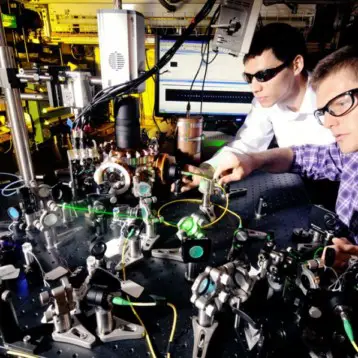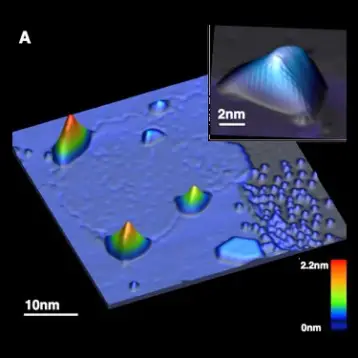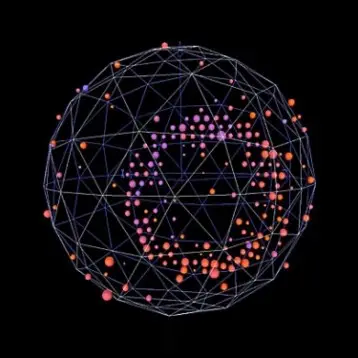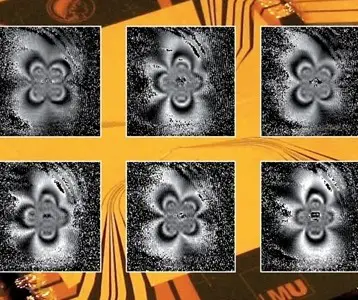Teams at French Atomic Energy Agency (CEA) and the French National Center for Scientific Research (CNRS) took up this challenge in 1996, marking the beginning of the Antares project. In February 2006, after a long phase focused on studying the marine environment, the first flexible detection line some 400 meters high, was laid at a depth of 2500 meters off the coast of Toulon, France. Currently there are 12 lines anchored to the seabed covering a surface area equivalent to four football fields. They are equipped with nearly 900 optical modules, the “eyes” of the telescope designed and built by the Antares teams. Half the lines were assembled at Particle Physics Center in Marseille (CPPM) which serves as the support laboratory for the experiment. The remaining lines were assembled at the Institute of Research into the Fundamental Laws of the Universe in France.�
Neutrinos are elementary particles without an electric charge that interact very weakly with matter. Unlike other particles, neutrinos can move through the universe in a straight line without being blocked by matter or deviated by magnetic fields along the way. Therefore, they are unique among cosmic messengers, helping astrophysicists observe and better understand certain objects where cataclysmic phenomena occur. When scientists are able to detect them, not a trivial task since they rarely interact with matter, they can infer about the neutrinos’ origins, thus improving our understanding of the universe. In order to detect the evasive neutrinos the detector must be as big as possible to increase the chances of intercepting these particles.�
The Antares detector is shielded from the background of cosmic rays by 2000 meters of water. Its abyssal depth provides total darkness, disturbed only by the faint light from a few bioluminescent animals. Its basic principle is to make earth itself the neutrino target; while it can stop other particles neutrinos can pass all the way through. Along the way some of the particles will collide with the nucleus of an atom. Although this occurrence is very rare, this collision produces a muon, a charged particle similar to an electron that moves in the same direction as the original neutrino.�
The muon can travel up to a dozen kilometers in the earth’s crust. Upon entering the water, it leaves a very faint trail of light. Antares’ optical modules were designed to detect this trail. In this manner it seems that the telescope looks through earth to observe the southern hemisphere’s sky. It is focused on this portion of the sky because it includes the Galactic Center, which is the main site of extremely violent phenomena.�
The tracking of cosmic neutrinos will help researchers expand their knowledge of high-energy astronomy. During recent decades astronomers have discovered several very high-energy photon sources, among them galaxies containing super-massive black holes, supernova remnants, and gamma-ray bursts. The photons may arise from the interaction of ultra-high-energy protons which constitute the cosmic rays that bombard the earth.�
These nuclear reactions also appear to produce cosmic neutrinos. Astroparticle physicists can’t observe cataclysmic events by detecting photons or protons since at very high energies these particles may be blocked by matter, making it hard to observe them in the distant universe. In contrast, high-energy neutrinos move through the universe in a straight line and thus provide direct insight into these extremely violent phenomena. Antares’ detection of neutrinos should provide astrophysicists with a unique source of information about these events, which will gradually give rise to a new map of the sky.�
Besides neutrinos detection, Antares offers a permanent, underwater infrastructure for multidisciplinary scientific study. It is already equipped with instruments, some of which are installed together on a dedicated thirteenth line: seismographs, instruments for measuring temperature and oxygen concentration, and a camera on the look-out for deep-sea fauna are some of the items on board. Scientists could use these instruments to help find answers to questions asked in other scientific fields, such as oceanography or climatology.�
Although the detector was only recently fully deployed, physicists have already used the data it generated in order to identify several hundred neutrinos. A few neutrinos from a distant source in the universe might well be hidden among them and it is only by accumulating and analyzing this data that researchers will be able to flush them out.�
TFOT has also covered IceCube, another underwater neutrino telescope, and the construction of a new telescope that will help discover dark matter. Other related TFOT stories include the 30 meter telescope, built by the TMT Observatory Corporation and Stellarium, new planetarium software that enables users to view a realistic image of the night skies.�
More information on the Antares telescope can be found on the CNRS website.










